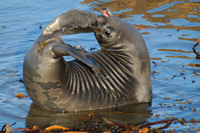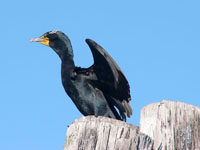Deep Sea Calendar - February
By Month - Jan | March | april | May | June | Aug | Sep | Oct | Nov | Dec
The winter months are excellent in the Channel Islands National Marine Sanctuary for tidepooling because afternoon low tides expose marine algae and invertebrates throughout the month.
During this month, gray whales (Eschrichtius robustus) can be seen traveling both southbound and northbound through the Channel, Gulf of the Farallones and Cordell Bank National Marine Sanctuaries on their annual migration from Alaskan feeding grounds to warm calving lagoons in Baja California, Mexico and back to Alaska.
Northern elephant seal (Mirounga augustirostris) pupping and breeding season on San Miguel Island throughout February.

Pacific harbor seal (Phoca vitulina) pupping season on San Miguel Island continues through May.
California Brown Pelicans (Pelecanus occidentalis californicus)California Brown Pelicans (Pelecanus occidentalis californicus) begin nesting on Anacapa and Santa Barbara Islands through February.

Peak egg-laying season for California brown pelicans (Pelecanus occidentalis californicus) on Anacapa and Santa Barbara Islands (March and April). Brant geese (Branta bernicla) stop to rest and feed in the Channel Islands region on their annual migration between Mexico and Alaska (March through May). Xantus's murrelets (Synthiboramphus hypoleucus) breed and nest on the Channel Islands (March through July).
Baitfish, including mullet and cigar minnows, move into the Florida Keys National Marine Sanctuary from northern waters, attracting sailfish, wahoo and king mackerel to the reef tract.
Northern elephant seals in the Monterey Bay National Marine Sanctuary continue to give birth to pups and many females wean their month-old pups abruptly by returning to sea for an extended foraging trip. Before leaving shore females become receptive and are mated by one or more bulls. Copulatory activity peaks on February 14, St. Valentine's Day.
The winter months are excellent for tidepooling in California because afternoon low tides expose marine algae and invertebrates (November-February).
During this month gray whales (Eschrichtius robustus) can be seen traveling both southbound and northbound through the Channel Islands, Monterey Bay, Gulf of the Farallones and Cordell Bank National Marine Sanctuaries. The whales follow an annual migration from Alaskan feeding grounds to the warm calving grounds in Baja California, Mexico before returning to Alaska.
Northern elephant seal (Mirounga augustirostris) pupping and breeding season on San Miguel Island (January and February).
 Deep Sea Crabs
Deep Sea Crabs